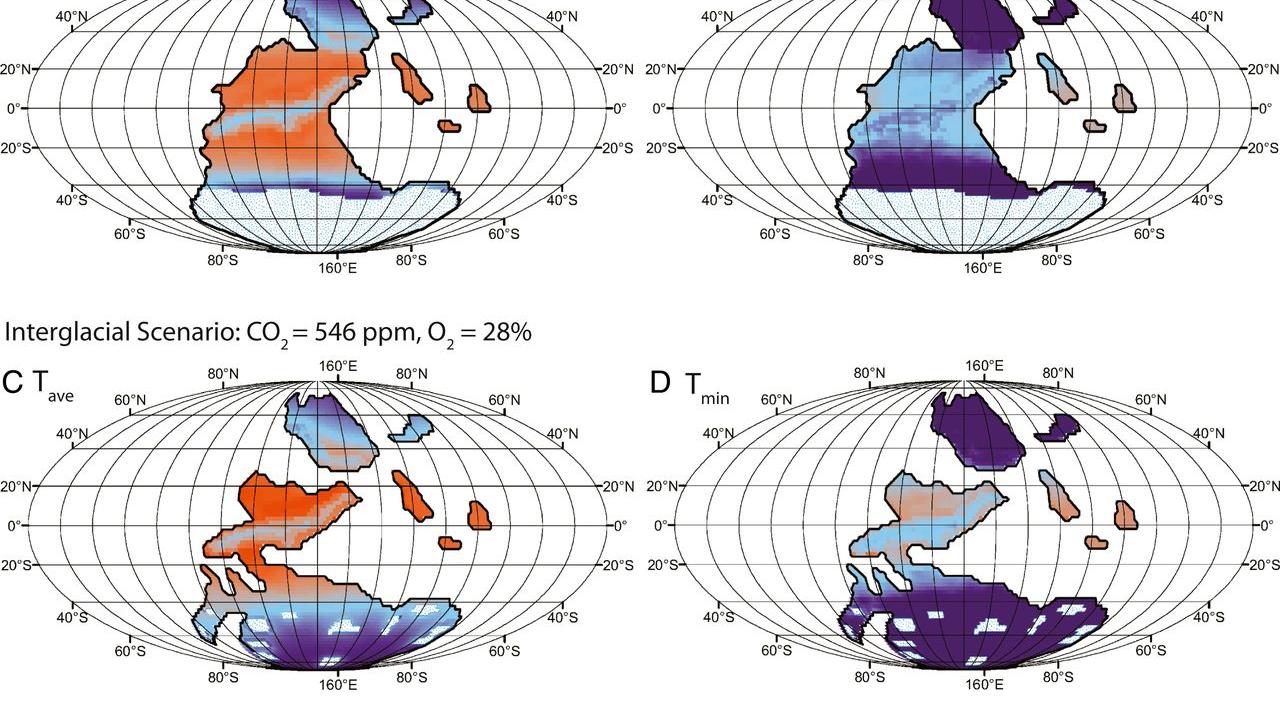A new study by scientists at Baylor University, UC Davis and others considers how tolerance of plants to freezing temperatures affected forest cover and hydrology during the Pennsylvanian period, roughly 340 million to 285 million years ago during the Paleozoic Era.
The study, published Oct. 19 in Proceedings of the National Academy of Sciences, suggests that plant freezing would have limited the geographical distribution of forest cover across the southern supercontinent Pangaea. This was the peak of the Earth’s last “icehouse” period before the present, when great ice sheets covered the southern hemisphere.
This period is our only analog in Earth history, when complex life existed, of a glaciated world with atmospheric carbon dioxide ranging from on par with pre-industrial levels rising to those predicted for the end of this century, said Isabel Montañez, distinguished professor of earth and planetary sciences and director of the John Muir Institute of Environment at UC Davis.
Freezing minimum temperatures likely limited the ability of forest plants to survive.
“Plants can tell us things about the time and place that they grew because plants have basic needs, kind of like people. But because plants can’t move around to get what they need, they have to build their ‘bodies’ to work well for where they’re growing,” said first author William Matthaeus, a graduate student at Baylor. “Because of this, plant fossils contain information about the way those plants functioned, but also the conditions they faced, even 300 million years ago.”
Forest cover alters energy exchange and climate, and climate in turn affects forest cover because it limits where plants can survive.
Modeling climate, water and ecosystems
“This work is particularly novel as it couples a process-based ecological and hydrological model, which we retrofitted so it could be applied to extinct plants, with a state-of-the-art Earth system model,” Montañez said. “This permitted us to interrogate what might have been the drivers of evolution of freeze tolerance in the Earth’s earliest forest ecosystems.”
The researchers used the combined model to simulate arboreal vegetation during the late Paleozoic ice age. Because existing global climate modeling projections do not account for differences of plant functional traits between contemporary and Paleozoic plants, the researchers used fossil-derived plant trait data to simulate global ecosystem processes.
They found that low forest cover due to cold temperatures increased surface runoff of freshwater and sediment in some regions. The freeze-induced runoff changed considerably between glacial and interglacial periods across Pangaea, and may have driven location-specific differences in mineral, sediment, organic matter and nutrient levels in the freshwater runoff into rivers and coastal marine environments.
“Even with the limited sample of the fossil record used here, hints toward the impact of freezing on 300-million-year-old plant communities are evident. We’re combining fossil-based inference about plant function with global climate modeling to bring ancient Earth to life. This is a critical pairing of disciplines for assembling the puzzle of natural history,” Matthaeus said.
Evolution of conifers
The global climate modeling showed that freezing temperatures were nearly global in occurrence and likely one limiting factor in forest cover distribution, even in the tropics. Less than 25% of unglaciated land that could support vegetation remained above freezing year-round.
At the time, gymnosperms (the group which includes conifers, cycads and ginkgos) were forming forests. The tough conditions of cold and drought may have shaped the evolution of gymnosperms leading to their worldwide success today, especially as forests in colder regions.
“Climate models are typically used to study average temperature trends over monthly or longer time scales in the Earth’s past. However, this approach ignores temperature extremes that are known to be critical for plant function and survival today. One novel aspect of this study is that we focus on daily temperature changes simulated by the model that plants likely endured during the Pennsylvanian,” said Sophia Macarewich, co-author and graduate student at the University of Michigan.
The incorporation of fossil-derived paleobotanical data into deep-time climate modeling can improve projections and understanding of past Earth systems as well as aid future climate change models, according to the authors.
“Further development of these methods may serve as a bridge for understanding the foundations of global ecosystems across Earth’s ancient past. By understanding how things worked throughout natural history, we have a better chance of understanding our own future,” Matthaeus said.
Additional authors on the paper are: at Baylor, Joseph White and Jon Richey, a recent graduate of UC Davis; Jonathan Wilson, Haverford College; Jennifer McElwain, Trinity College Dublin; Christopher Poulsen, University of Michigan; Michael Hren, University of Connecticut; and William DiMichele, Smithsonian Institution. The work was supported by grants from the NSF and European Research Council.
Media Resources
Freeze tolerance influenced forest cover and hydrology during the Pennsylvanian (PNAS)
Baylor-led Study Finds Forest Cover and Runoff Influenced by Freezing Temperatures During Late Paleozoic Ice Age (Baylor University)
A Bumpy Shift From Icehouse to Greenhouse (UC Davis News)
Kaitlyn Rieper is a Senior Communications Specialist at Baylor University.
